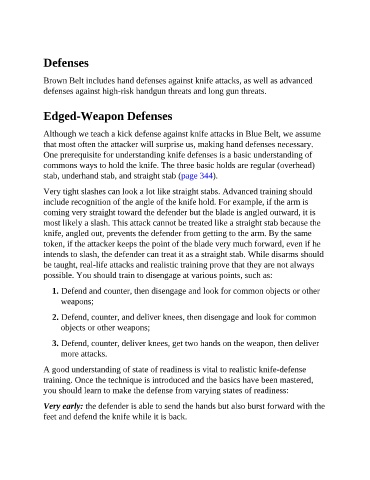Page 697 - Complete Krav maga : the ultimate guide to over 250 self-defense and combative techniques
P. 697
Defenses
Brown Belt includes hand defenses against knife attacks, as well as advanced
defenses against high-risk handgun threats and long gun threats.
Edged-Weapon Defenses
Although we teach a kick defense against knife attacks in Blue Belt, we assume
that most often the attacker will surprise us, making hand defenses necessary.
One prerequisite for understanding knife defenses is a basic understanding of
commons ways to hold the knife. The three basic holds are regular (overhead)
stab, underhand stab, and straight stab (page 344).
Very tight slashes can look a lot like straight stabs. Advanced training should
include recognition of the angle of the knife hold. For example, if the arm is
coming very straight toward the defender but the blade is angled outward, it is
most likely a slash. This attack cannot be treated like a straight stab because the
knife, angled out, prevents the defender from getting to the arm. By the same
token, if the attacker keeps the point of the blade very much forward, even if he
intends to slash, the defender can treat it as a straight stab. While disarms should
be taught, real-life attacks and realistic training prove that they are not always
possible. You should train to disengage at various points, such as:
1. Defend and counter, then disengage and look for common objects or other
weapons;
2. Defend, counter, and deliver knees, then disengage and look for common
objects or other weapons;
3. Defend, counter, deliver knees, get two hands on the weapon, then deliver
more attacks.
A good understanding of state of readiness is vital to realistic knife-defense
training. Once the technique is introduced and the basics have been mastered,
you should learn to make the defense from varying states of readiness:
Very early: the defender is able to send the hands but also burst forward with the
feet and defend the knife while it is back.

